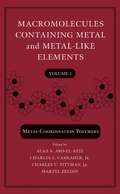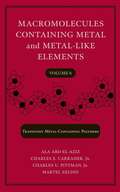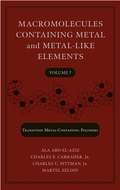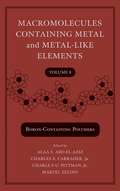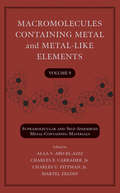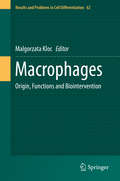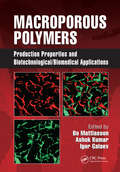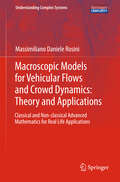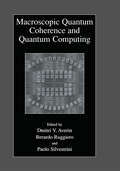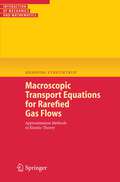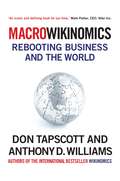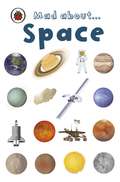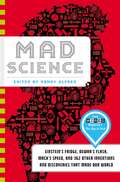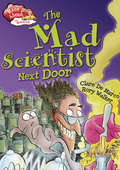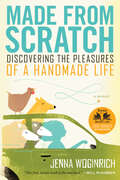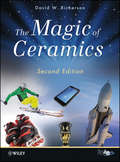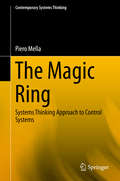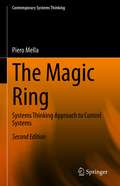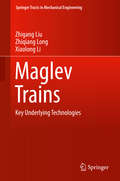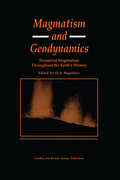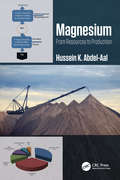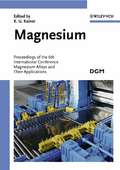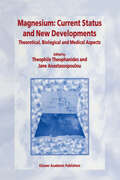- Table View
- List View
Macromolecules Containing Metal and Metal-Like Elements, Volume 5: Metal-Coordination Polymers (Macromolecules Containing Metal and Metal-like Elements #17)
by Martel Zeldin Alaa S. Abd-El-Aziz Charles E. Carraher Charles U. PittmanThis series provides a useful, applications-oriented forum for the next generation of macromolecules and materials. The fifth volume in this series provides useful descriptions of the transition metals and their applications. Transition Metals are covered in 2 volumes, the second part is covered in Volume 6.
Macromolecules Containing Metal and Metal-Like Elements, Volume 6: Transition Metal-Containing Polymers (Macromolecules Containing Metal and Metal-like Elements #6)
by Martel Zeldin Charles E. Carraher Charles U. Pittman Alaa S. Abd-El-AzizThis series provides a useful, applications-oriented forum for the next generation of macromolecules and materials. The sixth volume in this series provides useful descriptions of the transition metals and their applications, edited by high-quality team of macromolecular experts from around the world.
Macromolecules Containing Metal and Metal-Like Elements, Volume 7: Nanoscale Interactions of Metal-Containing Polymers (Macromolecules Containing Metal and Metal-like Elements #7)
by Alaa S. Abd-El-Aziz Martel Zeldin Charles E. Carraher Charles U. PittmanThis series provides a useful, applications-oriented forum for the next generation of macromolecules and materials. This volume, seventh in the series, covers nanoscale interactions of metal-containing polymers. Example chapters include: * Nanoscale Clusters and Molecular Orbital Interactions in Macromolecular-Metal Complexes * Metal Oxide Clusters as Building Blocks for Inorganic-Organic Hybrid Polymers
Macromolecules Containing Metal and Metal-Like Elements, Volume 8: Boron-Containing Particles (Macromolecules Containing Metal and Metal-like Elements #8)
by Charles E. Carraher Charles U. Pittman Martel Zeldin Alaa S. Abd-El-AzizThis series provides a useful, applications-oriented forum for the next generation of macromolecules and materials. Applications include non-linear optical materials, specialty magnetic materials, liquid crystals, anticancer and antiviral drugs, treatment of arthritis, antibacterial drugs, antifouling materials, treatment of certain vitamin deficiencies, electrical conductors and semiconductors, piezoelectronic materials, electrodes, UV absorption applications, super-strength materials, special lubricants and gaskets, selective catalytic and multi-site catalytic agents.
Macromolecules Containing Metal and Metal-Like Elements, Volume 9: Supramolecular and Self-Assembled Metal-Containing Materials (Macromolecules Containing Metal and Metal-like Elements #9)
by Martel Zeldin Alaa S. Abd-El-Aziz Charles E. Carraher Charles U. PittmanVolume 9 in a scientific research series, covering macromoleculesThis book, Macromolecules Containing Metal and Metal-like Elements, presents research developments in the study of: supramolecular chemistry, supramolecular architecture and supramolecular self-assemblies. The topics addressed involve materials containing metals and metal-like elements as well as the possible applications of hybrid materials. The volume offers a broad series of coverage with conclusions and perspectives for the various areas covered.
Macrophages: Origin, Functions and Biointervention (Results and Problems in Cell Differentiation #62)
by Malgorzata KlocThis volume gives a state-of-the-art overview on macrophage functions in various invertebrate and vertebrate systems and diseases. It also covers various aspects of macrophage development and formation, behavior and response to nano- and biomaterials, the latter of which have become very important components of modern medicine. Macrophages are evolutionarily conserved phagocytotic cells. In recent years macrophages have emerged as one of the most versatile cells of immune system, which, depending on the milieu and circumstance, participate in development or inhibition of cancer, regeneration, wound healing, inflammation, organ rejection and interaction between mother and a fetus. This book will be of particular interest to researchers working in immunology, cancer research, developmental biology, or related fields.
Macroporous Polymers: Production Properties and Biotechnological/Biomedical Applications
by Bo Mattiasson Ashok Kumar Igor Yu. GaleaevMacroporous polymers are rapidly becoming the material of choice for many tissue engineering, bioseparation, and bioprocessing applications. However, while important information is scattered about in many different publications, none, to date, have drawn this information together in user-friendly format, until now. Meeting the need for an accessibl
Macroscopic Models for Vehicular Flows and Crowd Dynamics: Classical and Non–Classical Advanced Mathematics for Real Life Applications (Understanding Complex Systems)
by Massimiliano Daniele RosiniThis monograph presents a systematic treatment of the theory for hyperbolic conservation laws and their applications to vehicular traffics and crowd dynamics. In the first part of the book, the author presents very basic considerations and gradually introduces the mathematical tools necessary to describe and understand the mathematical models developed in the following parts focusing on vehicular and pedestrian traffic. The book is a self-contained valuable resource for advanced courses in mathematical modeling, physics and civil engineering. A number of examples and figures facilitate a better understanding of the underlying concepts and motivations for the students. Important new techniques are presented, in particular the wave front tracking algorithm, the operator splitting approach, the non-classical theory of conservation laws and the constrained problems. This book is the first to present a comprehensive account of these fundamental new mathematical advances.
Macroscopic Quantum Coherence and Quantum Computing
by Dmitri V. Averin Berardo Ruggiero Paolo SilvestriniThis volume is an outgrowth of the Second International Workshop on Macroscopic Quantum Coherence and Computing held in Napoli, Italy, in June 2000. This workshop gathered a number of experts from the major Universities and Research Institutions of several countries. The choice of the location, which recognizes the role and the traditions of Naples in this field, guaranteed the participants a stimulating atmosphere. The aim of the workshop has been to report on the recent theoretical and experimental results on the macroscopic quantum coherence of macroscopic systems. Particular attention was devoted to Josephson devices. The correlation with other atomic and molecular systems, exhibiting a macroscopic quantum behaviour, was also discussed. The seminars provided both historical overview and recent theoretical ground on the topic, as well as information on new experimental results relative to the quantum computing area. The first workshop on this topic, held in Napoli in 1998, has been ennobled by important reports on observations of Macroscopic Quantum Coherence in mesoscopic systems. The current workshop proposed, among many stimulating results, the first observations of Macroscopic Quantum Coherence between macroscopically distinct fluxoid states in rf SQUIDs, 20 years after the Leggett's proposal to experimentally test the quantum behavior of macroscopic systems. Reports on observations of quantum behaviour in molecular and magnetic systems, small Josephson devices, quantum dots have also been particularly stimulating in view of the realization of several possible q-bits.
Macroscopic Transport Equations for Rarefied Gas Flows: Approximation Methods in Kinetic Theory (Interaction of Mechanics and Mathematics)
by Henning StruchtrupThe well known transport laws of Navier-Stokes and Fourier fail for the simulation of processes on lengthscales in the order of the mean free path of a particle that is when the Knudsen number is not small enough. Thus, the proper simulation of flows in rarefied gases requires a more detailed description. This book discusses classical and modern methods to derive macroscopic transport equations for rarefied gases from the Boltzmann equation, for small and moderate Knudsen numbers, i.e. at and above the Navier-Stokes-Fourier level. The main methods discussed are the classical Chapman-Enskog and Grad approaches, as well as the new order of magnitude method, which avoids the short-comings of the classical methods, but retains their benefits. The relations between the various methods are carefully examined, and the resulting equations are compared and tested for a variety of standard problems. The book develops the topic starting from the basic description of an ideal gas, over the derivation of the Boltzmann equation, towards the various methods for deriving macroscopic transport equations, and the test problems which include stability of the equations, shock waves, and Couette flow.
MacroWikinomics: New Solutions for a Connected Planet
by Don TapscottThe sequel to the international #1 bestseller, Wikinomics. Wikinomics showed how mass collaboration was changing businesses around the world.MacroWikinomics takes it beyond the boardroom to show how the mass collaboration is revolutionizing the way we live, work, and create.The era of the monolithic, self-contained, inwardly focused corporation is over. In Wikinomics Don Tapscott and Anthony D. Williams showed how the internet is changing the way the very smartest business managers think about structures and strategies in the 21st century. Now, in MacroWikinomics, they demonstrate how this revolution in thinking is spreading outwards to other sectors - from education and scientific institutions, to entertainment and media, to government and democracy. MacroWikinomics is a groundbreaking and definitive look at achieving success for a new century, a new media, a new generation and a new economy.LONGLISTED FOR THE 2010 FT AND GOLDMAN SACHS BOOK AWARDS
Mad About Space
by LadybirdAre you mad about space? From astronauts and asteroids to rockets and robots, this book is packed with fascinating facts and key information for all young space enthusiasts.Ladybird's Mad About series is all about giving its readers all the facts they could possibly need about their favourite subjects. Get ready to impress all your friends with all your new knowledge!
Mad Science: Einstein's Fridge, Dewar's Flask, Mach's Speed, and 362 Other Inventions and Discoveries That Made Our World
by Randy Alfred Tony Long365 days of inventions, discoveries, science, and technology, from the editors of Wired Magazine. On January 30, Rubik applied for a patent on his cube (1975). On the next day, 17 years earlier, the first U.S. Satellite passed through the Van Allen radiation belt. On March 17, the airplane "black box" made its maiden voyage (1953). And what about today? Every day of the year has a rich scientific and technological heritage just waiting to be uncovered, and Wired's top-flight science-trivia book Mad Science collects them chronologically, from New Year's Day to year's end, showing just how entertaining, wonderful, bizarre, and relevant science can be. In 2010, Wired's popular "This Day in Tech" blog peaked with more than 700,000 page views each month, and one story in 2008 drew more than a million unique viewers. This book will collect the most intriguing anecdotes from the blog's run-one for each day of the year-and publish them in a package that will instantly appeal to hardcore techies and curious laypeople alike.
The Mad Scientist Next Door (Race Ahead With Reading #8)
by Clare De MarcoElla's next door neighbour, Mr Willis, is seriously mean. She stays out of his way as much as possible. But when she accidentally catapaults her baby brother's favourite teddy bear into Mr Willis' garden, Ella is forced to go over to his house. And Ella is in for a SHOCK!Race Ahead with Reading is the perfect introduction to reading chapters with brand new page turning reads in five short bite size chapters, to encourage children to take the driving seat with their reading.
Made from Scratch: Discovering the Pleasures of a Handmade Life
by Jenna WoginrichIn a hectic world of mass-produced food, clothing, and entertainment, it&’s easy to miss out on the simple pleasures of doing things for yourself. Young web designer Jenna Woginrich chronicles her adventures as she learns to embrace the idea of self-sufficiency in all aspects of her life, including sewing her own clothes, growing her own food, and creating her own fun outside of the mainstream. Woginrich&’s hilarious, heartbreaking, and soul-satisfying journey will bring joy and inspiration to those who dream about a more independent lifestyle.
The Magic of Ceramics
by David W. RichersonMost people would be surprised at how ceramics are used, from creating cellular phones, radio, television, and lasers to its role in medicine for cancer treatments and restoring hearing. The Magic of Ceramics introduces the nontechnical reader to the many exciting applications of ceramics, describing how ceramic material functions, while teaching key scientific concepts like atomic structure, color, and the electromagnetic spectrum. With many illustrations from corporations on the ways in which ceramics make advanced products possible, the Second Edition also addresses the newest areas in ceramics, such as nanotechnology.
The Magic of Ceramics
by David W. RichersonMost people would be surprised at how ceramics are used, from creating cellular phones, radio, television, and lasers to its role in medicine for cancer treatments and restoring hearing. The Magic of Ceramics introduces the nontechnical reader to the many exciting applications of ceramics, describing how ceramic material functions, while teaching key scientific concepts like atomic structure, color, and the electromagnetic spectrum. With many illustrations from corporations on the ways in which ceramics make advanced products possible, the Second Edition also addresses the newest areas in ceramics, such as nanotechnology.
The Magic Ring: Systems Thinking Approach to Control Systems (Contemporary Systems Thinking)
by Piero MellaThis book presents a gradual path toward “educating” readers in understanding how Control Systems truly operate and in recognizing, simulating and improving them in all fields of activity. Starting from the hypothesis that knowledge of Control Systems is not only a technical fact but also represents a discipline – that is, “A discipline is a developmental path for acquiring certain skills or competencies. (…) To practice a discipline is to be a lifelong learner. You “never arrive”; you spend your life mastering disciplines.” (Senge, 2006, p. 10) – Piero Mella has set the objective of making Control Systems a topic that is, in a certain sense, simple and attractive by turning to the effective symbolism typical of Systems Thinking models and avoiding too technical and formal a treatment of the subject. Thus readers should know that this is not an engineering, physics, biology or economics text, nor a mathematics one either. Technical or mathematical tools are not necessary to construct Control Systems; instead the book adopts a highly simple and universal logic behind the notion itself of control process and the simple and universal action of the Control Systems that produce this process.The Magic Ring: Systems Thinking Approach to Control Systems is divided into 10 chapters. Chapter 1 seeks to review the basic language of Systems Thinking and the models it allows us to create, while Chapter 2 introduces the control process, presenting the theoretical structure of four simple Control Systems we all can observe and manage. In Chapter 3 a general typology of Control Systems is proposed with examples taken from observations of reality. The view of Control Systems is broadened in Chapter 4 by introducing two important generalizations: 1. multi lever Control Systems, with levers that are independent or dependent of each other; 2. multi-objective systems, with independent or interdependent objectives. Chapter 5 outlines the guidelines for recognizing, observing or designing Control Systems and presents the problems that arise regarding their logical realization, introducing the fundamental distinction between symptomatic and structural control. Chapters 6-9 undertake a “mental journey” through various “environments”, increasingly broader in scope, suggesting to the reader how to recognize therein Control Systems that, by their ubiquitous presence, make the world possible in all its manifestations. Finally Chapter 10 covers ideas about a Discipline of Control Systems and the human aspects of control.
The Magic Ring: Systems Thinking Approach to Control Systems (Contemporary Systems Thinking)
by Piero MellaThis book presents a new understanding on how control systems truly operate, and explains how to recognize, simulate, and improve control systems in all fields of activity. It also reveals the pervasive, ubiquitous and indispensable role of control processes in our life and the need to develop a “control-oriented thinking”—based on uncomplicated but effective models derived from systems thinking—that is, a true “discipline of control.” Over the book’s thirteen chapters, Piero Mella shows that there are simple control systems (rather than complex ones) that can easily help us to manage complexity without drawing upon more sophisticated control systems. It begins by reviewing the basic language of systems thinking and the models it allows users to create. It then introduces the control process, presenting the theoretical structure of three simple control systems we all can observe in order to gain fundamental knowledge from them about the basic structure of a control system. Then, it presents the anatomy of the simplest “magic ring” and the general theoretical model of any control system. This is followed by an introduction to a general typology of control systems and a broader view of control systems by investigating multi-lever control systems and multi-objective systems. The book undertakes the concepts through various environments, increasingly broader in scope to suggest to readers how to recognize therein control systems manifestations in everyday life and in natural phenomena. Updated for the 2nd edition, new chapters explore control systems regulating the biological environment and the organizations, with an in-depth study of the control of quality, productivity, production, stocks and costs. Finally, it concludes by dealing with the learning process, problem-solving, and designing the logical structure of control systems.
Maglev Trains: Key Underlying Technologies (Springer Tracts in Mechanical Engineering)
by Zhigang Liu Zhiqiang Long Xiaolong LiThe motion of the train depends on the traction of linear motors in the vehicle. This book describes a number of essential technologies that can ensure the safe operation of Maglev trains, such as suspension and orientation technologies, network control and diagnosis technologies.This book is intended for researchers, scientists, engineers and graduate students involved in the rail transit industry, train control and diagnosis, and Maglev technology.
Magmatism and Geodynamics: Terrestrail Magmatism Throughout the Earth's History
by O. A. BagatikovMagnatism is the only true endogenic process for generating new material on the Earth's surface. Obviously, magmatism and tectonic movements are reflections of geodynamics, that is, physical processes which occur in deep-seated environments. What are the interrelationships between magmatism and tectronics? How did the character of terrestrial magmatism change through time and are there any irregularities in this process?
Magmatism and Geodynamics: Terrestrail Magmatism Throughout the Earth's History
by O. A. BogatikovMagnatism is the only true endogenic process for generating new material on the Earth's surface. Obviously, magmatism and tectonic movements are reflections of geodynamics, that is, physical processes which occur in deep-seated environments. What are the interrelationships between magmatism and tectronics? How did the character of terrestrial magmatism change through time and are there any irregularities in this process?
Magnesium: From Resources To Production
by Hussein K. Abdel-AalMagnesium is one of the most abundant minerals in seawater. Extracting magnesium from seawater could reduce cost of this mineral, resulting in positive implications for industries that use it. This book addresses mineral process engineering with emphasis on magnesium and provides practicing engineers and students with comprehensive knowledge on magnesium and how it is extracted from seawater and magnesium ores. It takes a chemical engineering approach as separation of magnesium from seawater involves the application of the powerful science of chemistry and transport phenomena principles. This monograph discusses magnesium resources and occurrence, includes an exploration study on deriving magnesium and mineral salts from seawater, and features coverage of magnesium chloride. It also covers commercial methods for magnesium production as an end product, current and prospective applications in the energy domain, and offers an account of the use of magnesium to store hydrogen in the form of magnesium hydride.
Magnesium: Proceedings of the 6th International Conference - Magnesium Alloys and Their Applications
by Karl U. KainerThe need for light-weight materials, especially in the automobile industry, created renewed interest in innovative applications of magnesium materials. This demand has resulted in increased research and development activity in companies and research institutes in order to achieve an improved property profile and better choice of alloy systems. Here, development trends and application potential in different fields like the automotive industry and communication technology are discussed in an interdisciplinary framework.
Magnesium: Theoretical, Biological and Medical Aspects
by T. Theophanides Jane AnastassopoulouThis book presents the lectures and posters of some of the main leaders in the field of th magnesium research and medical applications delivered at the 8 International Symposium on Magnesium, which took place on 5-9 October, 1997 in Heraklion, Crete under the chairmanship of Professor Theophilos Theophanides. The meeting was sponsored by the National Technical University of Athens and Ministry of Industry, Energy and Technology. The aim of this meeting was to promote research and applications of magnesium and interface between medical doctors, clinicians and scientists in order to understand the mechanisms responsible for magnesium involvement in the pathogenesis of diseases, its biological significance, metabolism and many other utilizations which are associated with membranes and cells. The success of this interface is due to the contribution of its participants who came from all continents and to their high scientific level. The topics, which were presented, and the questions, which were asked, concerned mechanisms of mode of action of free magnesium cations, Mg2+, hydrated cations, 2 Mg2+. 6 HP, and magnesium linked cations Mg +.LxH 0, where L: ligand and x = 2 1...6 Hp. We would like to express our utmost gratitude to the sponsers and to extend our deep appreciation and thanks to all those who helped and encouraged the scientific and material organization of this meeting. We wish to thank all the members of the scientific committee and the organizing committee.
